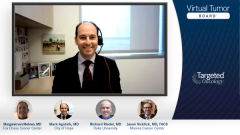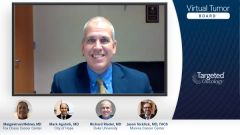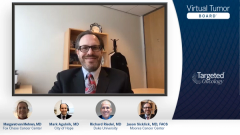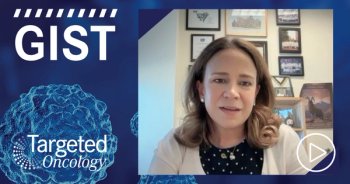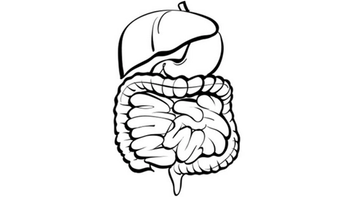
Case 1: Molecular Testing in GIST
Experts discuss the considerations of lines of therapy, comment on molecular testing, and the role of repeat biopsies.
Episodes in this series

Mark Agulnik, MD: If we follow the FDA and to some extent NCCN [National Comprehensive Cancer Network] Guidelines, there is a clear algorithm on how to treat a patient with a GIST [gastrointestinal stromal tumor]. However, over the last few years we’ve all seen enough data and been participants in clinical trials where we are using molecular testing at different time periods and whether we should test again at progression of disease. Potentially the molecular profile is going to look different.
What do you guys do with respect to your treatments? How are you incorporating repeat biopsies into the management of your patients?
Richard Riedel, MD: In my practice I’m not routinely doing it. It’s a great clinical trial question. It needs to be answered. It’s certainly something I think about a lot. If I do have someone, for example, who undergoes surgery for limited progressive disease, we may consider doing a repeat molecular testing. But to be quite honest, rarely if ever has it changed what my next treatment would be. At least in my practice, I follow the FDA-approved sequence of agents and at least with rare exception—for example, D842V mutation. I don’t deviate from that, but I’m interested to hear what others think. I would be interested to hear Jason’s thoughts on molecular testing.
Jason Sicklick, MD, FACS: It’s a pretty standard part of our practice in terms of managing patients with GIST, whether metastatic or in the adjuvant setting or for that matter also in the neoadjuvant setting. We recently published a paper looking at the cost effectiveness of doing next-generation sequencing, either before they have started therapy versus waiting for them to progress on first- or second-line therapy and then being tested. What the data suggested was that it was actually more cost effective in the first-line setting in patients with metastatic disease to do molecular testing to identify whether they’ve got a KIT mutation vs a PDGFRA mutation in order to better tailor therapy.
Because often the question becomes: why not just treat them first and then we’ll test them later on. The data for that study was suggestive of the fact that it was theoretically based on the modeling that led to better outcomes in those patients. It’s pretty standard as part of our practice.
In terms of follow-up, if we have tissue from a resection, in that scenario we’ll send out for testing. I wouldn’t necessarily say frequently we’ll just biopsy somebody as a snap reflex after progression. We’ll often move them along the sort of second-line therapy with sunitinib as our next step. If things continue to progress and we’re not making any headway or they’re progressing, then we’re going to think about perhaps getting a biopsy in that scenario in order to identify potentially other molecular targets.
Margaret von Mehren, MD: In clinical trials, we commonly will incorporate blood to look at circulating tumor DNA [ctDNA], which has advantages and disadvantages to standard tissue collection. When somebody is progressing, you sample 1 site unless you’re completely resecting everything. You’re getting just that 1 site and what’s there. Circulating tumor DNA may provide you with a broader impression of what’s actually present in all tumors, but the technology to date is not 100% sensitive and doesn’t necessarily pick up all mutations. It’s nice to have and will probably be much more useful in the future when the technology is more robust.
Jason Sicklick, MD, FACS: Totally agree.
Mark Agulnik, MD: Yes, it sounds as if everyone agrees that whenever considering any systemic therapy mutational testing, molecular testing should be done prior to the initiation of systemic therapy. It sounds as if after progression, the enthusiasm is somewhat tempered. Mark, what do you do in your practice?
Mark Agulnik, MD: I would do similar. I would only retest if I send someone to surgery and I had a surgical specimen. I wouldn’t send someone for a biopsy just for the sake of doing the test. I have not done the circulating tumor cells off a clinical trial.
Margaret von Mehren, MD: The only time I’ve actually done that is with somebody we tried to get tissue from and the biopsy was negative or we just couldn’t get enough tissue. It was somebody with metastatic disease, and we were able to get their mutation. This was in the setting of frontline therapy, so it’s important to know.
Jason Sicklick, MD, FACS: Early on when the ctDNA assays were coming on the market, we did a lot of testing, and we didn’t see a lot of positive findings. Now, if you look at the data that are published by different groups, it’s really only a fraction of the patients who are going to shed DNA with those scenarios being often very large tumors or very advanced metastatic disease. For the small tumor or the small-volume disease where it’s pretty subtle but they are clearly progressing, you may not find positive ctDNA result in those either.
Mark Agulnik, MD: If I can just ask a question about patients who undergo endoscopic ultrasound biopsies for localized disease, sometimes we have situations when don’t have enough tissue to do molecular testing. What are you guys doing in that situation? Are you sending them for weekly procedures? Are you starting them? This is for an individual, for example, who the surgeon says would really benefit from some shrinkage. Do you reflexive start imatinib in the absence of testing? Do you send them for a repeat biopsy to get testing? What do you guys do?
Mark Agulnik, MD: I reflexively start treatment, figuring that the average patient will derive benefit from imatinib. Then I recheck them a few months later.
Margaret von Mehren, MD: It depends where they’ve had their prior biopsy and how the biopsy was obtained. I certainly will send patients for an endoscopic ultrasound-guided biopsy if they’ve not had it before because that’s much likelier to get a good yield to get that information. But if they’ve had it before, it was nondiagnostic. I tend not to repeat it, and like Mark, I continue. Sometimes we’ll assess a little earlier than I might, unless there are some clinical clues that they’re deriving benefit.
Transcript edited for clarity.


